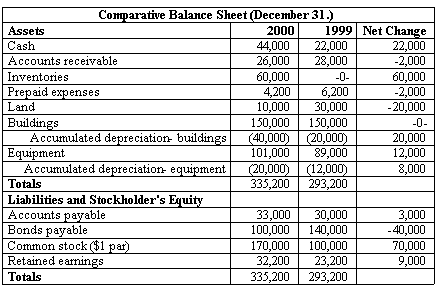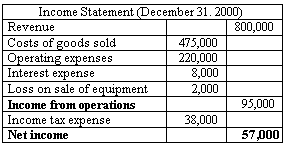- CFA Exams
- 2026 Level I
- Topic 4. Financial Statement Analysis
- Learning Module 4. Analyzing Statements of Cash Flows I
- Subject 4. The Indirect Method
Why should I choose AnalystNotes?
Simply put: AnalystNotes offers the best value and the best product available to help you pass your exams.
Subject 4. The Indirect Method PDF Download
The indirect method uses net income (as reported in the income statement) as the starting point in the computation of net cash flows from operating activities. Adjustments to net income necessary to arrive at net cash flows from operating activities fall into three categories: non-cash expenses, timing differences, and non-operating gains and losses. Adjustments reconcile net income (accrual basis) to net cash flows from operating activities. In other words, the indirect method adjusts net income for items that affected reported net income but did not affect cash.
The four-step process:
1. Start with net income.
2. Add back non-cash charges such as depreciation and amortization of intangibles. Cash payments for long-lived assets such as plants and intangibles occur when they are purchased. Purchase of these assets is reflected as an investing activity at that time. When depreciation expense is recognized in the current period, it simply indicates the paper allocation of original purchase cost to this period. As a result, expenses increase without a corresponding cash outlay. Since depreciation does not affect cash flow, it should be added back to net income to compute net CFO.
3. Add back losses and subtract gains from investing or financing activities. Examples include gains/losses from sale of property, plants and equipment (investing activity) or gains/losses from early retirement of debt (financing activity). Why? Disposal of fixed assets will be used to illustrate this. The gains and losses from the disposal of fixed assets appear on the income statement. However, disposal of fixed assets is an investing activity, so the entire cash receipt is shown as an investing cash inflow. Therefore, the gains or losses should be removed from net income so as to prevent double-counting cash flows. Note that it is the proceeds from disposal, not the gain or loss, that constitute the cash flow.
4. Adjust for changes in operating related accounts (current assets and current liabilities other than cash, short-term borrowings, and short-term investments). For example, an increase in current assets ties up cash, thereby reducing operating cash flow. An increase in current liabilities postpones cash payments, thereby freeing up cash and increasing operating cash flows in the current period. An increase in assets reduces cash and should be deducted from net income. An increase in liabilities increases cash and should be added to net income.
Note that short-term investments are considered an investing activity and short-term borrowing is considered a financing activity.
Example
Selton Co.'s balance sheet and income statement are presented below.


Additional information:
(a) Operating expenses include a depreciation expense of $34,000 and amortization of pre-paid expenses of $2,000.
(b) Land was sold at its book value for cash.
(c) A cash dividend of $48,000 was paid in 2000.
(d) An interest expense of $8,000 was paid in cash.
(e) Equipment with a cost of $36,000 was purchased for cash. Equipment with a cost of $24,000 and a book value of $18,000 was sold for $16,000 cash.
(f) Bonds were redeemed at their book value for cash.
(g) Common stock ($1 par value) was issued for cash.
Explanations of the adjustments to the net income of $57,000 are as follows:
a. Accounts receivable: The decrease of $2,000 should be added to net income to convert from the accrual basis to the cash basis.
b. Inventories: The increase of $60,000 represents an operating use of cash for which an expense was not incurred. This amount is therefore deducted from net income to arrive at cash flow from operations.
c. Pre-paid expense: The decrease of $2,000 represents a change to the income statement for which there was no cash outflow in the current period. The decrease should be added back to net income.
d. Accounts payable: When it increases, the cost of goods sold and the expense on a cash basis are lower than they are on an accrual basis. The increase of $3,000 should be added back to net income.
e. Depreciation expense: The depreciation expense for the building is $20,000. Due to the sale of equipment, the depreciation for equipment is (24,000 - 18,000) + 20,000 - 12,000 = $14,000. This amount plus $20,000 should be added back to net income to determine net cash flow from operating activities.
f. Loss on sale of equipment: The loss of $2,000 on sale of equipment should be added back to net income since the loss did not reduce cash (but it did reduce net income).
Cash flows from investing and financing activities:
a. Land: The sale of land for $20,000 is an investing cash inflow.
b. Equipment: The purchase of equipment for $36,000 is an investing cash outflow and the sale for $16,000 is an investing cash inflow.
c. Bonds payable: This financing activity used $40,000 cash.
d. Common stock: Common stock of $80,000 was issued as a financing cash inflow.
e. Retained earnings: The increase of $9,000 is the result of net income of $57,000 from operations and the financing activity of paying cash dividends of $48,000.
The statement of cash flows is prepared as follows:

User Contributed Comments 20
| User | Comment |
|---|---|
| wundac | CFO is already adjusted for non-cash charges and changes in working capital accounts: CFO = NI + NCC - WCInv |
| uformula | how does CFO not measure equipment replacement? Wouldn't it count as an investment activity as a purchase? or an operating activity for COGS as a labor cost? |
| thammy | Precisely what u said (uformula), investment cost for the new equipment goes under CFI not CFO. |
| soorajiyer | Beginning Net PPE + CAPEX - Depreciation - BV of Goods Sold = Ending Net PPE. Proceeds from sale of goods - BV of goods sold = Gain on sale of goods. |
| rocyang | The explaination for depreciation part is a bit tricky. If it's not explained in additional information, do we have to calculate it by ourselves? |
| JBezling | Could someone please explain the depreciation expense calculation? Thanks |
| gill15 | Its not calculated...given in additional information on bottom of chart. |
| gill15 | Was looking at the Direct Method Dep X. My Bad. Indirect got no idea how they got that. Dont even understand where they got the BV of land from. |
| fmhp | Indirect method derived from net Income. |
| teje | the depreciation expense from building was 20,000...as for the equipment they gave us the total orginal cost of the equipment sold = 24,000 in addition they gave us the current book value of this equipment, which was = 18,000. The difference between 24,000 - 18,000 = the total accumulated depreciaton for this equipment sold = 6,000. Now, 6,000 + 20,000 gives you the total depreciation accumulated to this date for equipment (includes the new equipment purchased + the equipment sold)--> 26,000 -12,000(which was the depreciation recognized last year) will give you the depreciation amount for this year for equipment = 14,000. Take this 14,000 change in depreciation for equipment, add it to the change in depreciation for buildings = 20,000 ... and you get the total depreciation for the year = 34,000 |
| Adi8232 | thanks teje |
| hit81 | Increase Decrease Assets outflows inflows Liabilities & Equity inflows outflows |
| gulfa99 | how was common stock increase of 80k calculated...please help! |
| Naoual | actually it's $70k |
| Shaan23 | In case nobody noticed. It's pretty tricky if you dont know with the direct method. Depreciation Expense is deducted for it because the Admin X includes depreciation X. Remember with most questions you will not include the depreciation X with the calculation with the Direct Method. This is a special case. |
| farhan92 | This chapter has made me a little less scared about financial statements. Before registering for the CFA exam i was trying to learn how to create financial models and found it quite frustrating trying to grasp the financial statements. So pass or fail i am glad i signed up for this exam! |
| unknown | The depreciation expense of $34,000: 1. As per Balance Sheet, the following depreciation costs are given: - Building: Increase of 20,000 - Equipment: Increase of 8,000 Right off the bat: +28,000 to be added back to the Operating Activity as non-cash expense 2. Accounting for the sale of the equipment: - Cost value of 24,000 and Book Value of 18,000 > implies a depreciation of this equipment of +6,000. Therefore, 6,000 needs to also be added back to the Operating Activity. Total depreciation: 28,000 + 6,000 = 34,000 |
| unknown | What's with these additional information sections... so convoluted imo |
| khalifa92 | the treatment of working capital in both direct and indirect are typically the same which makes the rest of the work easier. |
| CJHughes | LOS bookmarked. lots of moving parts |

Thanks again for your wonderful site ... it definitely made the difference.

Craig Baugh
My Own Flashcard
No flashcard found. Add a private flashcard for the subject.
Add